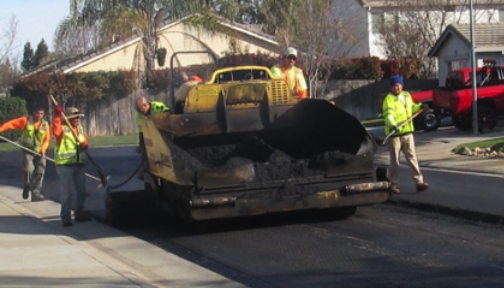Hot Mix Asphalt Paving: Redefining Business Property Landscapes
Hot Mix Asphalt Paving: Redefining Business Property Landscapes
Blog Article
Unlocking the Secrets of Hot Mix Asphalt Innovation
Exploring the depths of warm mix asphalt innovation uncovers a globe where specific formulas and meticulous procedures merge to shape our roadways and infrastructure. The combination of fillers, binders, and accumulations isn't merely a building task however a strategic orchestration of sturdiness and effectiveness.
Value of Hot Mix Asphalt
Warm Mix Asphalt plays a critical function in contemporary framework advancement due to its durability and cost-effectiveness. As one of the most typically utilized leading product for roads, highways, and parking great deals, Hot Mix Asphalt uses a variety of benefits that add to its relevance in construction tasks. One vital advantage is its capacity to stand up to heavy traffic loads and extreme weather, giving a long-lasting and trusted surface for transport networks. Furthermore, Hot Mix Asphalt is affordable in both initial building and lasting maintenance, making it a recommended selection for lots of facilities jobs.
The sturdiness of Warm Mix Asphalt comes from its structure, that includes aggregates, binder, and filler materials that are carefully selected and blended to satisfy specific efficiency needs. This accurate mix results in a solid and adaptable sidewalk that can withstand regular usage without significant wear and tear. Warm Mix Asphalt is 100% recyclable, additional boosting its sustainability and environmental advantages. In general, the importance of Hot Mix Asphalt in facilities growth can not be downplayed, as it remains to be a keystone of contemporary building techniques.
Parts of Asphalt Mixes
The make-up of asphalt mixes consists of meticulously chosen accumulations, binder, and filler products that are essential for accomplishing details performance needs. Accumulations are the primary element of asphalt blends, providing toughness and security. The binder, commonly asphalt or asphalt cement, holds the aggregates with each other and provides versatility and resilience to the mix.
The combination and percentage of these components play a significant function in establishing the high quality and efficiency of the asphalt mix. Engineers thoroughly create the mix to fulfill certain demands, taking into consideration variables like traffic quantity, environment conditions, and sidewalk lifespan. Appropriate choice and harmonizing of accumulations, binder, and fillers are vital for producing sturdy, long-lasting asphalt pavements.
Combining and Manufacturing Strategies

Once the aggregates are picked, the binder, commonly asphalt cement, is added to bind the products together. The binder's quality and amount substantially affect the mix's stamina, versatility, and resistance to environmental factors. In addition, fillers like hydrated lime or Portland cement may be incorporated to boost particular characteristics of the asphalt mix, such as its workability or moisture resistance.
During production, the accumulations and binder are heated, typically between 250-325 ° F(121-163 ° C ), to assist in mixing and make sure correct finish of the aggregates. The blending procedure must be thorough to attain a homogeneous combination that promotes the desired efficiency qualities of the asphalt. Numerous methods, such as batch mixing or drum mixing, are employed to achieve constant and top quality asphalt mixes for construction jobs.
Factors Impacting Asphalt Efficiency
Variables influencing asphalt efficiency incorporate a variety of variables that influence the sturdiness, durability, and overall top quality of asphalt sidewalks. One key element is the high quality of materials made use of in the asphalt mix. The kind and resource of aggregates, the binder high quality, and the additives all play a considerable duty in determining the efficiency of the asphalt pavement. The gradation of accumulations is vital as it affects the mix's resistance, stability, and workability to rutting and cracking.

Environmental problems also influence asphalt efficiency. Temperature variations, moisture infiltration, and traffic loads can all influence the structural stability of the pavement. Layout considerations, such as pavement thickness and drain, are vital in making certain the long-term efficiency of the asphalt pavement. By meticulously taking into consideration these aspects, designers and contractors can optimize asphalt performance and enhance the life span of pavements.
Lasting Practices in Asphalt Modern Technology

In addition, the development of warm-mix asphalt (WMA) innovations has actually gotten traction in the last few years. WMA enables for the production and positioning of asphalt blends at reduced temperatures compared to standard hot-mix asphalt, leading to reduced energy intake and greenhouse gas emissions. Moreover, the use of porous asphalt mixes can aid minimize stormwater runoff issues by enabling water to penetrate via the sidewalk and into the ground, advertising all-natural water filtering and recharge processes. By implementing these sustainable methods, the asphalt industry can angled parking add to constructing a more eco-friendly and durable framework network.
Final Thought
In verdict, hot mix asphalt innovation plays an essential duty in modern facilities growth due to its toughness and cost-effectiveness. By meticulously stabilizing elements, utilizing appropriate blending strategies, and thinking about numerous aspects, engineers can produce high-grade asphalt blends that endure heavy traffic loads and rough climate condition. Welcoming sustainable methods, such as making use of warm-mix technologies and recycled products, better enhances the ecological kindness of asphalt technology.
Mixing and production strategies in hot mix asphalt modern technology include the accurate mix and processing of aggregates, binder, and fillers to create a high-performance and durable asphalt mix.Variables affecting asphalt performance incorporate a variety of variables that affect the resilience, long life, and overall high quality of asphalt pavements. Lasting techniques in asphalt technology include different campaigns intended at minimizing the ecological effect of asphalt production and paving processes. By incorporating reclaimed asphalt sidewalk (RAP) and recycled asphalt tiles (RAS) into new asphalt blends, the market can dramatically minimize the intake of raw materials and energy, while additionally decreasing land fill waste.
WMA permits for the production and placement of asphalt mixes at reduced temperatures compared to standard hot-mix asphalt, resulting in reduced power usage and greenhouse gas discharges.
Report this page